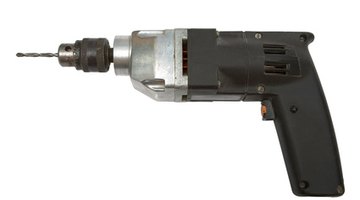Electric Drill Hazards
Power tools are a standard part of every handyman's gear. Of these tools, an electric drill is essential; it is useful in assembly, disassembly and ensuring structural security.

Despite the obvious benefits of this tool, the electric drill also has at least half a dozen significant potential hazards that may maim or even kill the electric drill user. Anyone who needs to use an electric drill should be familiar with these hazards.
Cords
A large number of drills now are cordless, running on battery power instead of relying on electrical outlets. Some heavy duty models, however, still require users to plug the drill into an electrical outlet, and even battery-operated drills have to be plugged in for charging. If an electric drill user doesn't watch his step or how the cord is moving as he works, he trip and fall on the cord or pull other equipment down by accident. The State Compensation Insurance Fund recommends using only grounded cords placed where they will not be tripping hazards.
Electrocution
Both the Occupational Safety and Health Administration (OSHA) and the Ohio Bureau of Workers' Compensation state that shock and electrocution is the most feared danger of any power tool, including drills. Electric drills, even those that are battery operated, still function via an electrical charge. Drill users may get a potentially deadly shock if they use a drill with a frayed or improperly grounded cord, or if they use a drill that has a worn motor. The OBWC claims that even slight shocks are dangerous because they may cause the drill user to lose control of the drill.
Debris
Unlike a manual drill, an electric drill can propel debris in many directions with high velocity. Small particles like sawdust can fly into the eyes and cause irritation, according to the State Compensation Insurance Fund. Other debris may puncture the skin or other body tissues.
Puncture
The State Compensation Insurance Fund claims that puncture of skin and tissue is a leading hazard with electric drills. Punctures can happen due to debris, but they also can happen any time that the user loses control of the drill or drill bit.
Fire
If an electric drill is improperly wired or plugged in, or if the drill is worn, it may be incapable of handling the electrical current that flows through it. Even if the user does not get shocked, the heat generated by the electrical current may ignite a fire.
Disease
Electric drills work in a number of unsanitary environments--bits enter multiple materials, any one of which could carry pathogens, and then the user handles these bits. In addition, bits that aren't kept clean may rust and provide an environment for diseases like tetanus. The State Compensation Insurance Fund recommends always checking the cleanliness of the drill and bits to prevent illness.
The Drip Cap
- Power tools are a standard part of every handyman's gear.
- Some heavy duty models, however, still require users to plug the drill into an electrical outlet, and even battery-operated drills have to be plugged in for charging.
- The OBWC claims that even slight shocks are dangerous because they may cause the drill user to lose control of the drill.
- Small particles like sawdust can fly into the eyes and cause irritation, according to the State Compensation Insurance Fund.
- The State Compensation Insurance Fund recommends always checking the cleanliness of the drill and bits to prevent illness.
References
Resources
Writer Bio
Wanda Thibodeaux is a freelance writer and editor based in Eagan, Minn. She has been published in both print and Web publications and has written on everything from fly fishing to parenting. She currently works through her business website, Takingdictation.com, which functions globally and welcomes new clients.
Photo Credits
- Electric drill with a drill on a white background image by terex from Fotolia.com
- Electric drill with a drill on a white background image by terex from Fotolia.com
More Articles



